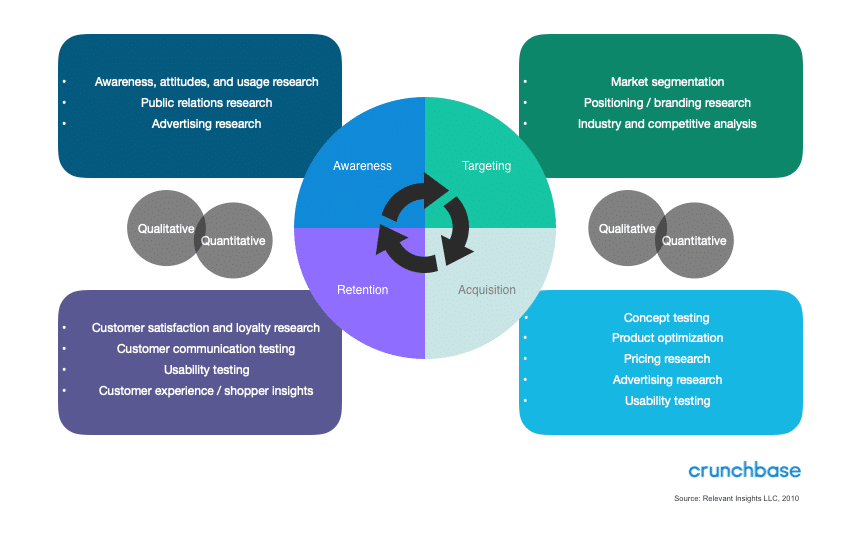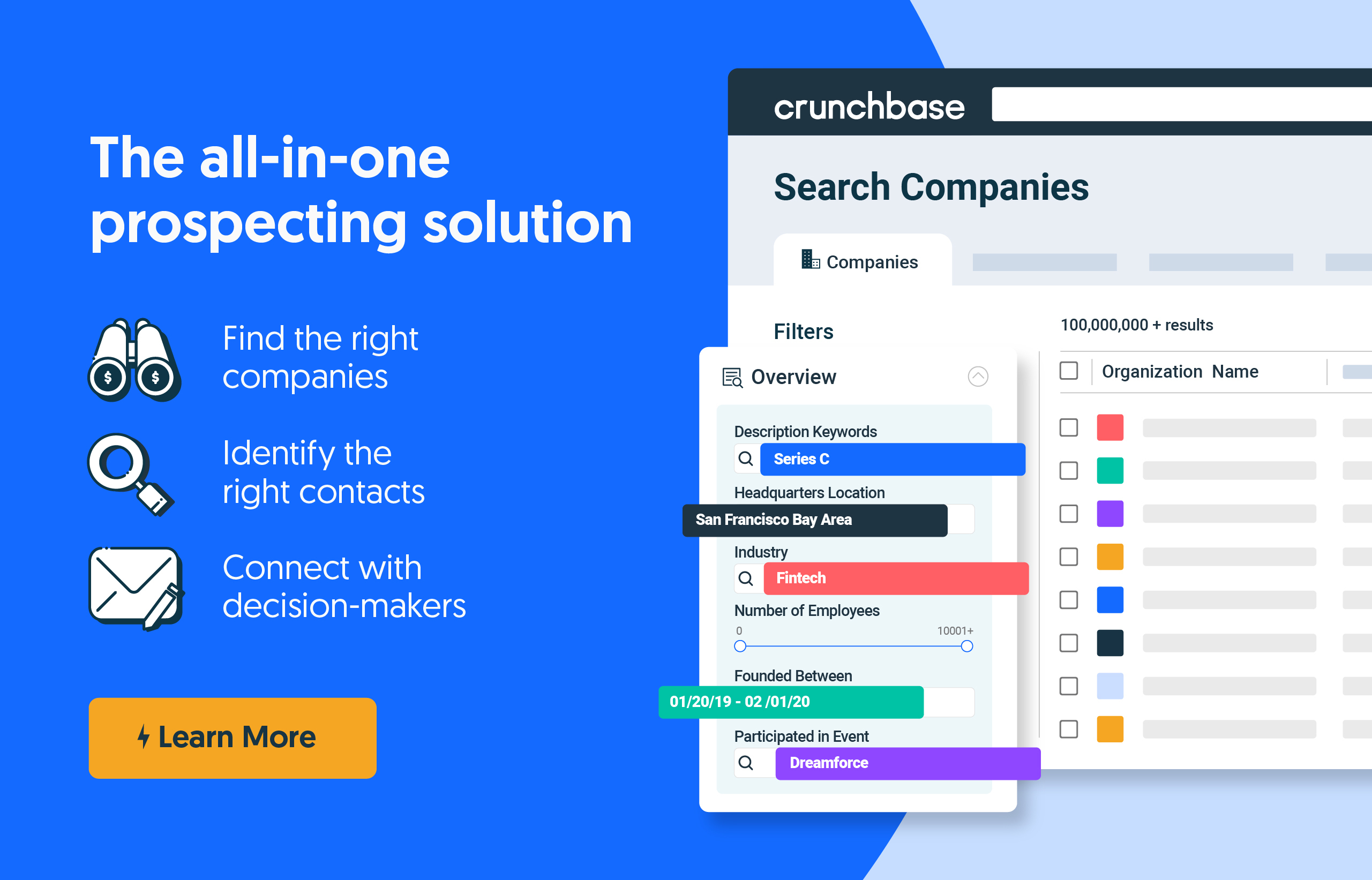Market research can help startups understand where they should be placing their resources and time. It can tell you everything from how people are perceiving your company, as well as which features to drop or continue developing. And while there are plenty of ways to conduct market research, not every market research method is right for every situation.
Search less. Close more.
Grow your revenue with all-in-one prospecting solutions powered by the leader in private-company data.
Market research can help play a major role in developing your product, marketing, and overall business strategy. Understanding the different market research methods can be the difference between wasting months of engineering time or exceeding your ambitious revenue targets.
We review the types of market research as well as the market research methods you can pursue based on your primary objectives and business goals.
The 2 types of market research
All market research falls under two distinct categories: primary research and secondary research.
Primary research looks at any data you collect yourself (or someone you pay). It encompasses analyzing current sales, metrics, and customers. It also takes into account the effectiveness of current practices, while taking competitors into account.
Secondary research looks at data that has already been published by others. It includes reports and studies from other companies, government organizations, and others in your industry.


10 market research methods
The type of data you need will decide which market research technique to use. Here are the most commonly used market research methods:
Primary research methods
These primary research methods will help you identify both qualitative and quantitative data. Qualitative data is information that cannot be measured while qualitative data is taken from a large sample size and is a statistically significant mathematical analysis.
1. Interviews
Great for: expert advice
Consisting of one-on-one discussions, interviews are a great source of qualitative data. You can either perform interviews by telephone, video conference, or face-to-face. Interviews are great for an in-depth look for target audience insights.
In-depth interviews are great when expert advice is needed or when discussing highly complex or sensitive topics. Interviews are usually 10 to 30 minutes long with 25 to 75 respondents.
2. Surveys
Great for: understanding brand awareness, satisfaction and loyalty analysis, pricing research, and market segmentation.
One of the most commonly used market research methods, Surveys are an easy way to understand your target audience and allow you to test a large sample size to determine if findings are true across a larger segment of your customers.
3. Questionnaires
Great for: Customer feedback and satisfaction surveys (NPS surveys), and when you want more detail on your target audience and customer base.
Do not confuse questionnaires for surveys! While surveys are aggregated for statistical analysis, questionnaires are a set of written questions used for collecting information.


Questionnaires are used to collect information rather than draw a conclusion. Surveys can include a questionnaire, but a survey must aggregate and analyze the responses to the questions.
When writing questionnaires for market research, keep the number of questions in mind.
In one study, SurveyMonkey found that questionnaires with 40 questions have about a 10% lower response rate than questionnaires with 10 questions. The more questions, the less likely people will finish your questionnaire.
4. Focus groups
Great for: Price testing, advertising concepts, product/messaging testing
Even with the rise of big data, focus groups have remained an integral part of how companies build their products, strategy, and messaging. Focus groups are intentionally compromised by a group of purposefully selected individuals. Above all, the collaborative setting ensures that members of the group are able to interact and influence each other.
Typically these open and interactive groups are composed of around five to 12 screened individuals. Make sure that your participants are diverse so you can get a range of opinions and you have enough representation from several segments of your market.
Many smaller startups will conduct DIY focus groups and will use video conferencing technology, which is one of the most cost-effective and time-efficient market research methods.
This is a great resource to see some good questions to ask your focus groups as well as what topics focus groups should touch on.
5. User groups
Great for: Feature testing, UX and web design feedback
User groups are used to gather UX data and provide insight for website design. User groups usually meet regularly to discuss their experience with a product, while researchers capture their comments.
Here’s a great guide on how to format questions for user groups.
6. Test markets
Great for: Testing new marketing campaigns
Test markets represent a larger market. Using a test group as well as a control group can show you the success of a new landing page, messaging copy, or CTA button. We particularly like the free version of Google Optimize to get quantitative data on how your experiment is performing based on a specific goal.


Secondary research methods
Secondary research can help establish a starting point prior to diving into more expensive primary research techniques. While there is a lot of data on the web regarding basic statistics, you may have to purchase a distinct data provider for a more in-depth look at your market.
Crunchbase Pro and Marketplace partners are a great and inexpensive way to start your secondary research directly on Crunchbase.com.
7. Competitor benchmarks
Great for: Understanding your revenue, churn, operating costs, sales, profit margin, and burn rate.
Competitor benchmarks are the most valuable and widely used of the secondary research methods. Moreover, competitor benchmarks measure specific growth metrics or key performance indicators in comparison to business within the same industry and of a similar size.
You can use Crunchbase Pro to find how much companies in a certain industry are raising and who are the leading players with our global coverage on companies ranging from pre-seed to late-stage. So, as one of the most informative of the market research methods, competitive benchmarks are a great way to inform your business strategy.
Free Crunchbase registered users have access to revenue estimates as well as web traffic data.
8. Sales data
Great for: Understanding your audience and where to place marketing efforts.
Taking a look at internal sales data not only reveals profitability but also helps market researchers segment customer trends.
However, taking a look at competitive sales data is a great way to make sure that you’re meeting the numbers you should be targeting as well as capturing the full potential of the market
9. Government publications and statistics
Great for: General demographic information and larger trends
The U.S. Census Bureau is a great resource of national demographic data. You can also review patents as a preview of industry trends and future innovation.
Also, you can find additional data and research from Data.gov, The World Bank, as well as the Pew Research Center to help inform your market research decisions.
10. Commercial data
Great for: Greater insight into industry trends and reports
If you’re interested in purchasing secondary market research, commercial data is available. For comprehensive reports, Mintel and IBISWorld are both traditional market research companies that provide commercial data.
Additionally, to choose which type of market research method is best for your goal, follow this graph from Relevant Insights. Begin with the metric you’re trying to move and then backtrack into a targeted market research method.


How can Crunchbase help with my market research?
Crunchbase gives market researchers flexible access to Crunchbase’s complete company data. Innovative teams and leaders in market research rely on Crunchbase’s live company data to build powerful internal databases and research insights in respective industries. Learn more about how Crunchbase can help you with your market research.






